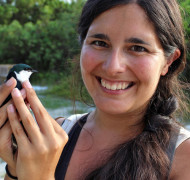A new study published in Behavioral Ecology suggests that increased aggression in urban song sparrows is related to resource availability. The study, by Virginia Tech researchers Sarah Foltz and Ignacio Moore, was featured this week in Science.
“City folk have a reputation for being less friendly than their rural counterparts, and the same appears to be true for garden birds. Urban song sparrows (Melospiza melodia) are more aggressive toward their neighbors than are sparrows out in the country. But whereras the temperament of human city-dwellers is often attributed to the sheer density of people, this isn’t the case for sparrows. The team measured birds’ responses to recordings of another male’s song, noting how often males approached or attacked the speakers, and found that aggression depended not on the density of sparrows, but on the availability of food in the environment. Counterintuitively, male sparrows responded more aggressively in the city, where there tends to be more food, and rural birds became more aggressive when provided with food supplements. The authors explain that the sparrows defend food-rich, high-quality territories more aggressively, but it isn’t clear whether this is an offensive or a defensive strategy; city birds may be more aggressive because a territory with more food is more valuable to them, or because their abundant resources attract more thieves.”
Original Article:
Foltz, Sarah L.,Ross, Allen E., Laing, Brenton T.,Rock, Ryan P., Battle, Kathryn E., Moore, Ignacio T. Get off my lawn: increased aggression in urban song sparrows is related to resource availability. Behavioral Ecology, doi:10.1093/beheco/arv111
Photo by: By Linda Tanner from Los Osos, California, via Wikimedia Commons

